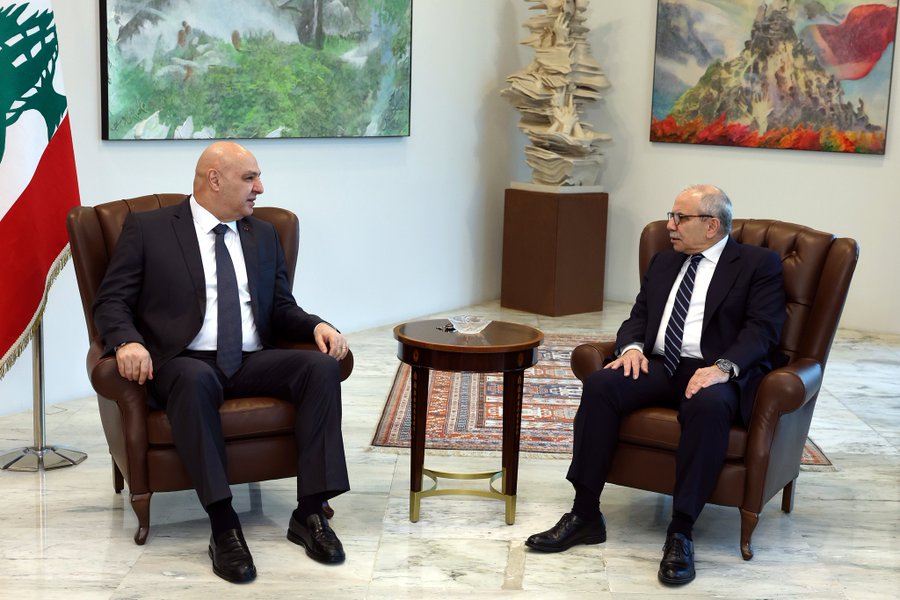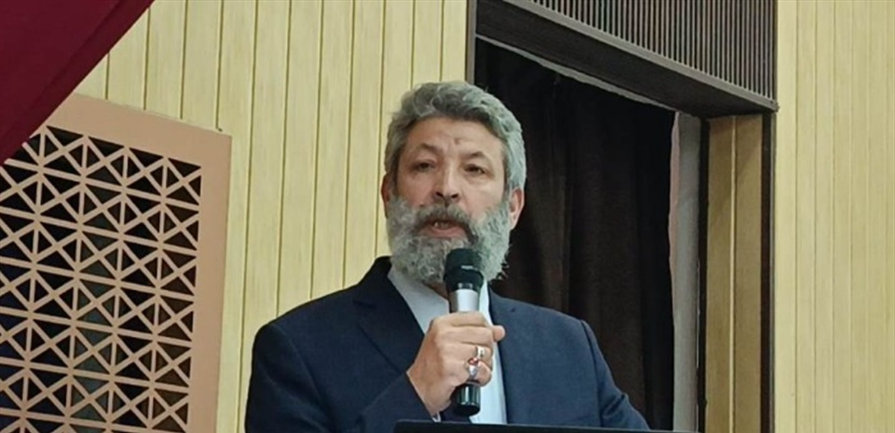 Ahmed Raya (Lebanon 24, October 19, 2025)
Ahmed Raya (Lebanon 24, October 19, 2025)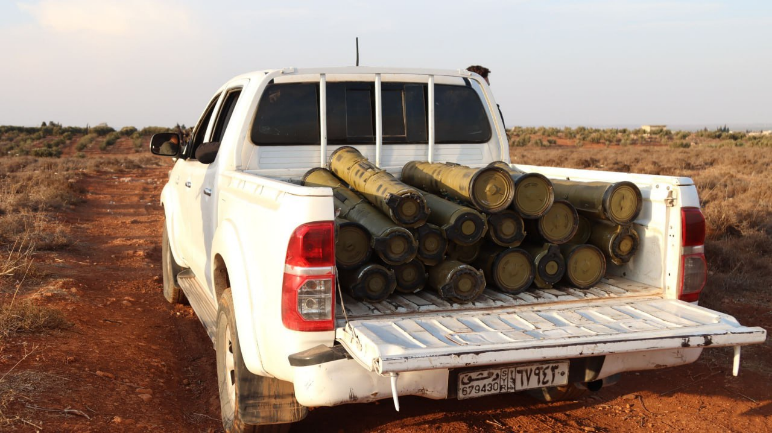 Shipment of Kornet missiles seized on the Syrian-Lebanese border (Telegram channel of the Syrian Ministry of the Interior, October 11, 2025)
Shipment of Kornet missiles seized on the Syrian-Lebanese border (Telegram channel of the Syrian Ministry of the Interior, October 11, 2025)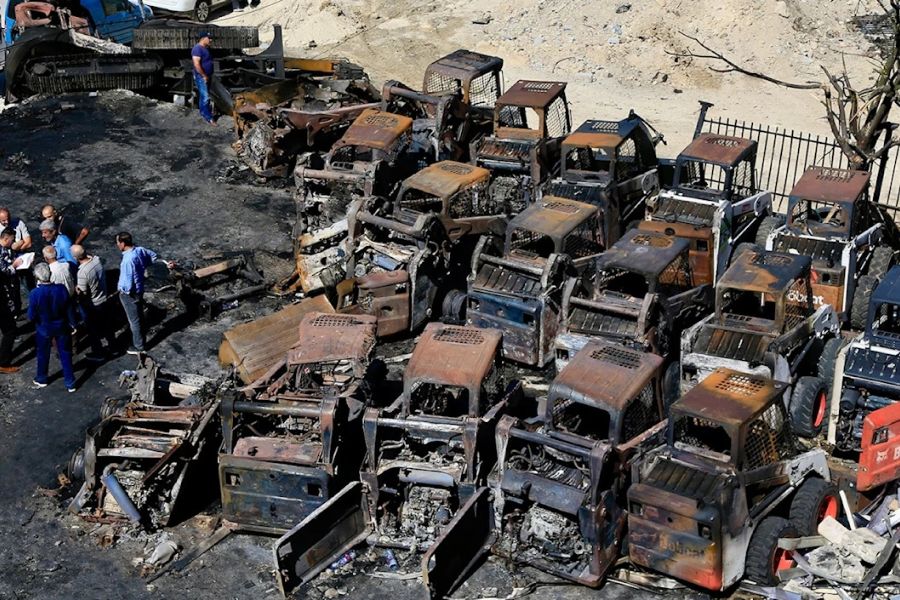 Results of an attack against a site for storing engineering vehicles in Msayleh (Al-Ahed, October 13, 2025).
Results of an attack against a site for storing engineering vehicles in Msayleh (Al-Ahed, October 13, 2025).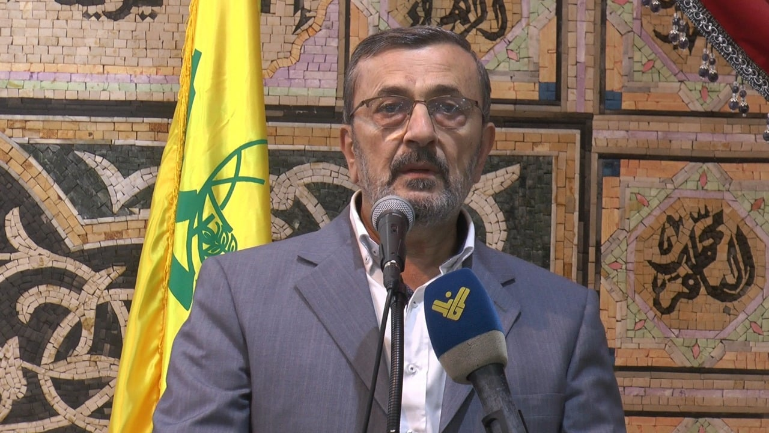 Hassan Ezzeddine (Lebanon Debate, October 12, 2025)
Hassan Ezzeddine (Lebanon Debate, October 12, 2025)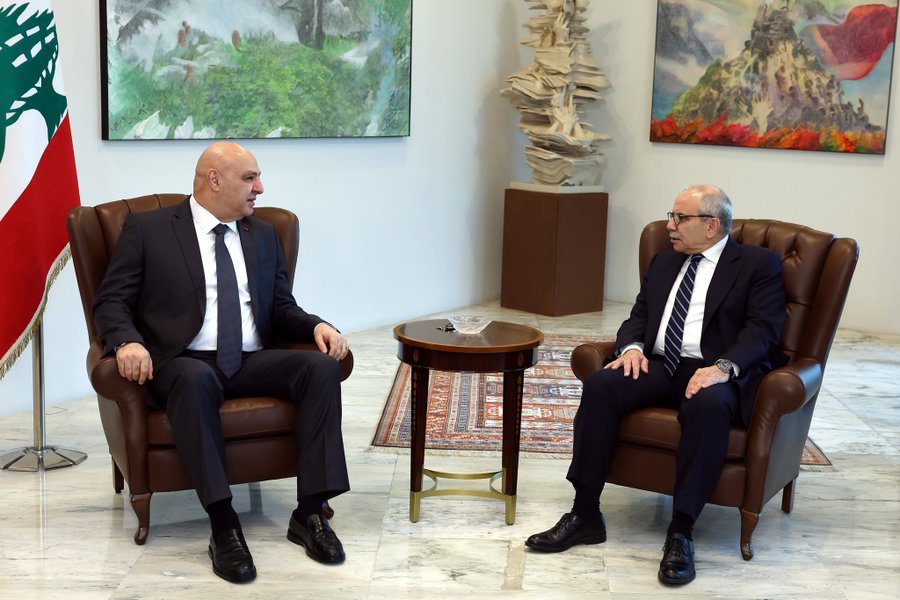 Lebanese President Aoun and Prime Minister Salam at a meeting in which they also discussed Israeli attacks (Lebanese Presidency X account, October 17, 2025)
Lebanese President Aoun and Prime Minister Salam at a meeting in which they also discussed Israeli attacks (Lebanese Presidency X account, October 17, 2025)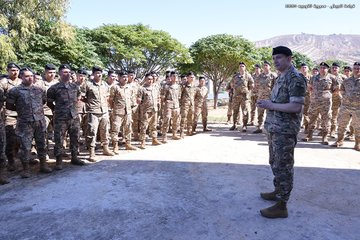 The commander of the Lebanese army visits his forces in southern Lebanon (Lebanese Army X account, October 13, 2025)Yuval Rosenberg
The commander of the Lebanese army visits his forces in southern Lebanon (Lebanese Army X account, October 13, 2025)Yuval Rosenberg
Highlights
Since the ceasefire between Israel and Lebanon went into effect on November 27, 2024, Hezbollah has been making efforts to restore its capabilities, which were severely damaged in the campaign against Israel between October 2023 and November 2024, while adapting the organization’s structure to the new reality. Senior Hezbollah officials have even declared that the organization is prepared for a new confrontation with Israel. Hezbollah’s reconstruction activities in southern Lebanon constitute a violation of the understandings prohibiting Hezbollah’s presence south of the Litani River.
In light of identifying accelerated efforts to reconstruct the organization’s infrastructure, the IDF carried out hundreds of attacks against Hezbollah operatives and the organization’s military infrastructure in southern Lebanon and other areas of the country. Since the beginning of October 2025, a total of 20 attacks have been carried out to enforce the ceasefire understandings, destroying capabilities that aided in reconstructing Hezbollah’s infrastructure, including hundreds of engineering vehicles and a concrete production quarry.
Hezbollah has continued the line it has taken since the beginning of the ceasefire, calling on the Lebanese authorities to intensify their efforts against “Israeli aggression,” while vaguely threatening that the “resistance” may lose its patience.
The Israeli strike that destroyed hundreds of engineering vehicles intensified the anger and criticism from the Lebanese leadership, which accused Israel of attempting to undermine Lebanon’s reconstruction efforts in general and efforts to reconstruct the villages in southern Lebanon in particular. Prime Minister Salam also instructed the Ministry of Foreign Affairs to file a complaint with the UN Security Council.
Against the backdrop of the ceasefire in the Gaza Strip and the attempt to increase American pressure on Israel, Lebanese President Aoun proposed opening indirect negotiations with Israel to resolve disputed issues. It was reported that Hezbollah did not reject the idea, but demanded as a precondition the cessation of strikes, withdrawal of IDF forces from southern Lebanon, and the release of Lebanese detainees held in Israel.
In the ITIC’s assessment, Hezbollah is expected to continue efforts to restore its capabilities despite IDF enforcement actions, with emphasis on areas north of the Litani River to minimize friction with Lebanese Army forces working to implement the state monopoly on weapons in southern Lebanon. The ITIC assesses that if the trend of Israeli strikes against Hezbollah operatives and infrastructure intensifies, Hezbollah is expected to increase criticism and pressure on state leadership, but it appears that for now, the organization remains restrained and will avoid direct action against Israel. However, if Israeli strikes result in widespread harm to uninvolved civilians, Hezbollah may respond more extensively under the pretext of “defending Lebanon.”
Hezbollah’s Efforts to Rebuild its Capabilities
According to the ceasefire understandings between Israel and Lebanon from November 27, 2024, which ended the fighting between Israel and Hezbollah that began on October 8, 2023, the presence of armed groups (with Hezbollah foremost among them) and military infrastructure not belonging to Lebanon’s official security forces is prohibited south of the Litani River in the country’s south. For this purpose, the Lebanese Army was required to deploy in southern Lebanon to dismantle all military infrastructure, seize all unauthorized weapons, and take control of unauthorized facilities involved in weapons production.[1] Subsequently, in early August 2025, the Lebanese government authorized the Lebanese Army to ensure the state monopoly on weapons, including disarming Hezbollah.[2] In early September 2025, the government accepted the army’s plan to implement the decision in several stages throughout all parts of the country (LBC, September 5, 2025).
Recently, reports have appeared that Hezbollah is in an advanced stage of restoring its military capabilities for another possible confrontation with Israel, nearly a year after the ceasefire came into effect, while adapting to the new reality in light of Israeli enforcement activity. Senior Hezbollah officials have also claimed that the organization has successfully rebuilt itself after the damage it sustained in the campaign against Israel. The following are notable examples:
Terrorism analyst and researcher Pierre Jabbour noted that Hezbollah has made a fundamental tactical and strategic change, with the organization returning to use “primitive means” while relying on a decentralized structure that will allow it to survive and adapt to prolonged attrition warfare against Israel’s intelligence, technological, and cyber superiority. In an article he published under the title “Hezbollah and the Stone Age,” Jabbour explained that the practical meaning is disconnecting Hezbollah’s activities from encrypted digital communication and transitioning to basic means such as messengers, signals, and landline communication, and returning to combat based on small cells, camouflage, secrecy, and exploitation of terrain and geography, similar to the organization’s first period of activity in the 1980s (An-Nahar, October 15, 2025).
An investigation in the French daily Le Figaro noted that Hezbollah is in an unprecedented state of clandestine operation, and that although it agreed to disarm in southern Lebanon, it maintains a military and operational presence in its other strongholds, primarily Beirut and the Bekaa Valley, as well as enjoying support among its Shiite base. Hezbollah MP Ali Fayyad confirmed that the organization has a “new secret military structure, with younger and more dynamic leadership,” while “a Hezbollah source” noted that Hezbollah operates clandestinely, similar to the 1980s, with separation between the military and political wings and shortened command chains. However, “a Hezbollah activist” admitted that panic and chaos still partially exist among the organization’s leadership and that this affects the command fabric and security behavior of the organization’s operatives (Le Figaro, October 18, 2025).
Ahmed Raya, Hezbollah’s public relations officer in the Bekaa, said at an event marking the first anniversary of the elimination of secretary-general Hassan Nasrallah and his designated successor Hashem Safieddine that “the resistance” has rehabilitated itself and rebuilt its capabilities. He added that “the resistance was not defeated and is ready for all developments and to confront all challenges” (Lebanese News Agency, October 19, 2025).

Ahmed Raya (Lebanon 24, October 19, 2025)
“Western intelligence sources” said that Hezbollah has increased its reconstruction pace recently, despite the Lebanese government’s decision to disarm it. According to the sources, Hezbollah is succeeding in rearming with weapons, including missiles, recruiting new fighters, and reconstructing sites and bases. They also noted that most of the organization’s reconstruction efforts occur north of the Litani River, rather than in the area south of the river, which is supposed to remain free of Hezbollah forces and weapons (i24News, October 21, 2025).
Syria also continues to serve as a weapons-smuggling route for Hezbollah in Lebanon, despite efforts by the new Syrian regime’s security forces to stop such activity. In October 2025, Syrian Interior Security foiled attempts to smuggle Kornet anti-tank missiles near al-Qusayr on the border with Lebanon and medium- and heavy-weapons shipments in the city of Homs (Telegram channel of the Syrian Ministry of the Interior, October 11, 2025; Al-Arabiya, October 12, 2025). The IDF also thwarted an attempt to smuggle arms from Syria to Lebanon via the Hermon region (IDF Spokesperson, October 18, 2025).

Shipment of Kornet missiles seized on the Syrian-Lebanese border
(Telegram channel of the Syrian Ministry of the Interior, October 11, 2025)
Israeli Enforcement of the Ceasefire Understandings
Several reports indicate that in a “side document” accompanying the understandings, the United States committed that Israel would maintain military freedom of action to strike in southern Lebanon in case of violation of the agreement by Hezbollah or another party (Israeli media, November 26, 2024). After the ceasefire came into effect, the IDF carried out hundreds of strikes against Hezbollah operatives and military infrastructure, due to violations of the understandings and the organization’s attempts to restore its capabilities. Most strikes focused on southern Lebanon, where the agreement completely prohibits Hezbollah’s presence, and they eliminated about 200 Hezbollah operatives, including field commanders and Radwan Force operatives, and destroyed existing military infrastructure or infrastructure being reconstructed, including near the border with Israel. In parallel, strikes were carried out against Hezbollah infrastructure in additional areas of Lebanon, north of the Litani River, including Beirut’s Dahiyeh and the Bekaa Valley, and against routes used by Hezbollah for smuggling on the Lebanon-Syria border.[3] According to data published in Lebanon, since the ceasefire came into effect, more than forty Israeli strikes have been carried out against bulldozers and excavators, killing more than twenty people and wounding dozens (Al-Akhbar, October 14, 2025).
Since the beginning of October 2025 (until October 22, as of 10:00), the IDF has carried out 20 strikes against Hezbollah targets, focusing on the organization’s attempts to reconstruct its infrastructure and operational capabilities. Among other things, strikes targeted a storage and display site for hundreds of engineering vehicles in the Tyre area, quarries of the “Green Without Borders” organization affiliated with Hezbollah[4] that were used for the production of concrete, a Hezbollah site for managing fire-and-defense array in the Beaufort Ridge (which has been struck multiple times in recent months), and Radwan Force training camps and weapons storage sites in the Bekaa Valley. Additionally, Hezbollah operatives were eliminated, some of whom were engaged in infrastructure reconstruction activities using engineering vehicles or were responsible for contact with villages in southern Lebanon (IDF Spokesperson, October 1-22, 2025).
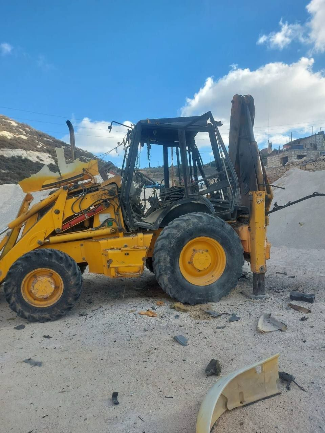

Right: Results of an attack against a site for storing engineering vehicles in Msayleh (Al-Ahed, October 13, 2025). Left: An excavator attacked while a Hezbollah operative was carrying out reconstruction work (Telegram channel in southern Lebanon – Watching the enemy, October 18, 2025)
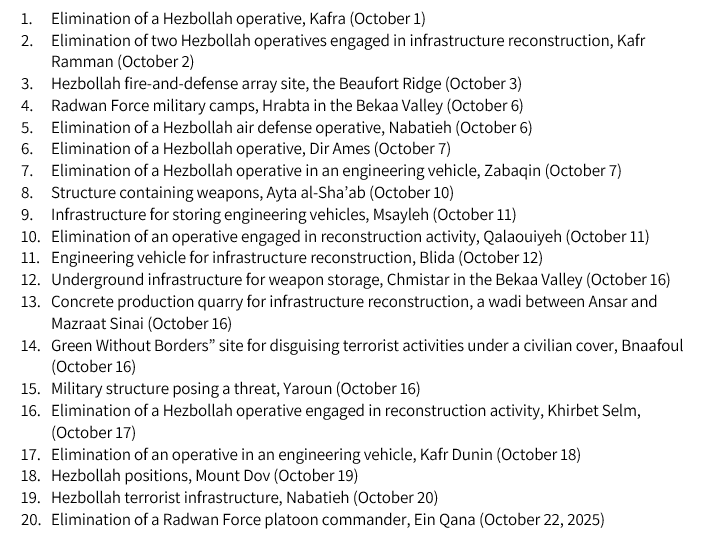
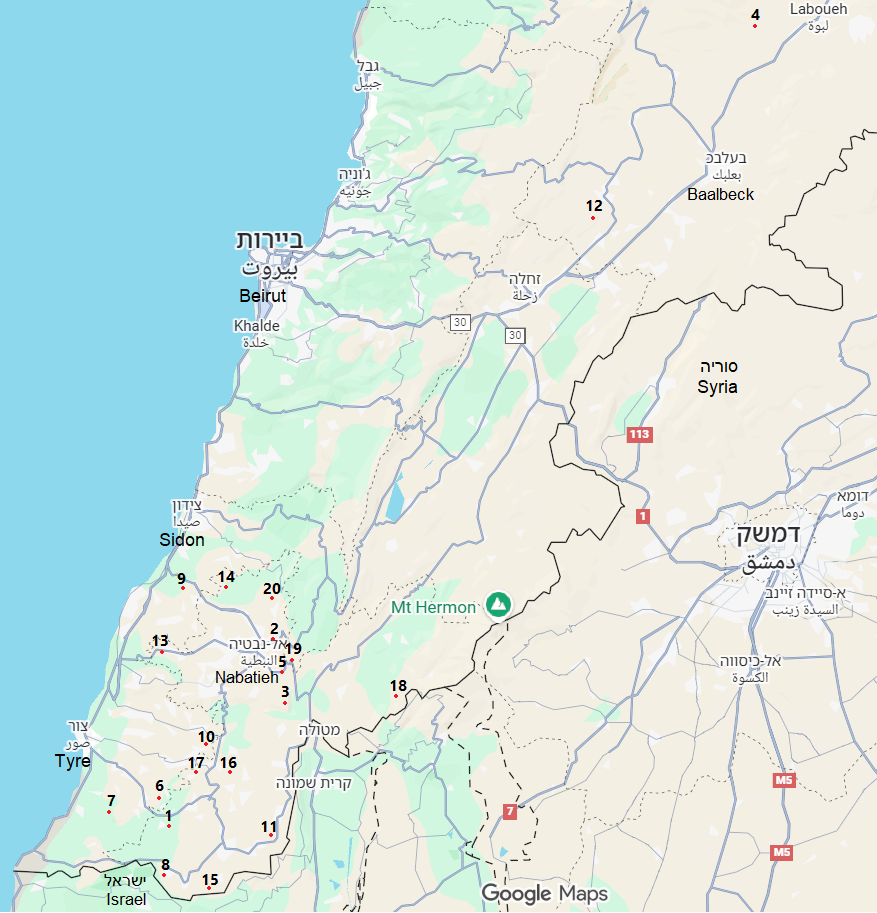
Map of IDF enforcement attacks in Lebanon, October 2025
(IDF Spokesperson and Lebanese media, October 1-22, 2025)
“Military sources in Lebanon” noted that Israeli strikes are no longer focused on specific sites but are part of a systematic strategy designed to expose Hezbollah’s clandestine movements or storage sites for medium and long-range missiles. According to the sources, Israel is implementing a policy of “tracking through fire,” based on intelligence capabilities covering all of Lebanon’s territory, and it strikes targets that have been attacked before based on the assessment that offensive weapons are hidden there or movements of Hezbollah operatives have been identified there (Aram News, October 8, 2025).
Lebanese Reactions to the IDF Enforcement Measures
Hezbollah
In response to IDF enforcement measures, Hezbollah has continued to present statements accusing Israel of “repeated violations” of the ceasefire agreement and gradual takeover of areas in southern Lebanon as part of what Hezbollah calls “an Israeli plan to expand its borders as part of the Greater Israel project.” Senior Hezbollah officials claimed that Israel is exploiting the international community’s silence and the weakness of the Beirut government to establish facts on the ground and called on the Lebanese government to take a more decisive stance against “Israeli aggression.” They also emphasized that the state’s supreme responsibility is to protect southern Lebanon’s citizens and prioritize the struggle against Israel over any attempt to deal with disarming Hezbollah, a move they claim “serves the enemy.” The following are notable statements:
After the strike on engineering vehicles in Msayleh (October 11, 2025), Hezbollah published a statement saying that the attack was part of repeated strikes against “civilians and economic infrastructure, aimed at preventing people from returning to normal life.” The organization called on Lebanon to act on the diplomatic and political level and submit an urgent complaint to the UN Security Council to pressure Israel to stop its strikes (Hezbollah’s Combat Information Unit Telegram channel, October 11, 2025).
Hezbollah MP Hassan Ezzeddine said that recent Israeli strikes reflect “aggressive rampage by the enemy” against all international laws. He added that in light of the strikes, talk about international law and human rights or international justice organizations has become meaningless because we face “a reality ruled by the logic of force and supremacy” (Lebanon Debate, October 12, 2025). In another statement, he said that “the resistance” in Lebanon has recovered, is still present, and is capable of confronting “the enemy” if it launches a ground offensive or tries to occupy additional territories. He added that “the resistance has not fallen, will not be defeated, and will not be broken” and that Israel would leave the areas under its control “sooner or later” (Al-Akhbar, October 22, 2025).

Hassan Ezzeddine (Lebanon Debate, October 12, 2025)
Mahmoud Qomati, deputy chairman of Hezbollah’s political bureau, said that Hezbollah is currently in a position of strength and emphasized that “the resistance’s patience” has limits. He added that the day may come when defense in Lebanon will turn into offense, and current equations will change “sharply.” Qomati also called on all parties in Lebanese politics to integrate into a defense strategy alongside the Lebanese Army (YouTube channel “Sawtak Plus,” October 14, 2025).
Hezbollah’s parliamentary bloc emphasized that “Israel’s escalation and continuation of massacres, assassinations, and criminal attacks in Lebanon send a clear message that the enemy will not stop its attacks.” This, according to the bloc, is “to prevent any attempt to reconstruct what the aggression destroyed.” The bloc stressed that this requires the government to double its efforts and take measures (Al-Manar, October 16, 2025).
Bloc leader Mohammad Raad stated that “the enemy’s aggressive behavior” from sea, land, and air, and violation of international laws will lead sooner or later to “harsh consequences” (Al-Manar, October 19, 2025).
Lebanon’s Leadership
Since the beginning of IDF enforcement measures against ceasefire understanding violations, the Lebanese leadership has been caught between local public opinion pressures, Hezbollah’s influence, and fear of renewed economic and security collapse. State leadership has accused Israel of “violating” Lebanese sovereignty and called on the international community, especially the US, to increase pressure on Israel, warning that the strikes and continued presence of IDF forces in five positions in southern Lebanon make it difficult to complete the Lebanese Army’s deployment and implement the state monopoly on weapons, steps required for receiving international aid for reconstruction.[5]
The Israeli strike against engineering vehicles in Msayleh intensified anger at the Lebanese leadership. “Government sources” said the vehicles were intended to assist in infrastructure reconstruction operations in 38 towns in southern Lebanon, as part of a project that was to receive $100 million in funding from previous loans obtained by the government. The sources claimed the strike was intended to send a message to the Lebanese government and people that they would not be allowed to reconstruct destroyed villages “before the Israeli demand [to disarm Hezbollah] is approved” (Al-Akhbar, October 13, 2025). Additionally, an-Najjariyah Mayor Abbas Halal noted that the strikes in Msayleh were carried out just 200 meters from the home of Parliament Speaker and Amal leader Nabih Berri, Hezbollah’s ally. Zafer Nasser, secretary-general of the Progressive Socialist Party, said that “an attack of this magnitude certainly carries several messages to many recipients, one of whom may be Nabih Berri” (Arab News, October 11, 2025).
Lebanese President Joseph Aoun said following the Msayleh strike that this was “blatant Israeli aggression against civilian sites without any excuse.” He wondered if, in light of the ceasefire in Gaza, there is “someone who thinks to compensate for Gaza in Lebanon to ensure their need to exist in terms of political livelihood through fire and killing” (An-Nashra, October 11, 2025). He accused Israel of “a systematic policy aimed at destroying productive infrastructure, blocking economic recovery, and targeting national stability under false security pretexts” (Lebanese Presidency X account, October 17, 2025).
Lebanese Prime Minister Nawaf Salam added that although Lebanon is committed to the ceasefire agreement and is working hard to limit weapons to the state, it is subjected almost daily to Israeli strikes. He called on countries worldwide to pressure Israel to stop the strikes and withdraw from Lebanon and urged them to assist in reconstruction that would contribute to stability in Lebanon and the entire region (An-Nashra, October 13, 2025). Salam also asked Lebanese Foreign Minister Youssef Rajji to submit an urgent complaint to the UN Security Council regarding Israel’s strikes “against civilian and commercial facilities in Msayleh” (An-Nashra, October 12, 2025). Hezbollah MP Ibrahim al-Moussawi welcomed the move and noted that “this is a step in the right direction, though belated.” He added they expect additional diplomatic and governmental steps in this direction (Ibrahim al-Moussawi’s X account, October 12, 2025).

Lebanese President Aoun and Prime Minister Salam at a meeting in which they also discussed Israeli attacks (Lebanese Presidency X account, October 17, 2025)
Against the backdrop of achieving the ceasefire in Gaza, Lebanese President Aoun also called for opening a channel of negotiations, direct or indirect, with Israel to ensure that Lebanon does not remain outside the crisis resolution efforts currently being conducted in the region but rather be part of them with the goal of preventing war, killing, and displacement of residents. He mentioned that maritime border demarcation was formulated in an agreement with Israel, through US and UN mediation, and expressed hope that the time will come when Israel will be committed to ceasing its military operations against Lebanon and a negotiation process will begin (Lebanese News Agency, October 13, 2025). Prime Minister Salam added that Aoun raised the proposal to push the US to intervene in the situation since negotiations reached a dead end “as a result of Israel’s insistence on violating the agreement and continuing its strikes.” According to him, if the US responds to the proposal, it will create a breach that can be used to implement Resolution 1701 and consolidate the 1949 armistice agreement (Asharq al-Awsat, October 20, 2025).
In this context, Hezbollah did not reject the possibility of opening indirect negotiations with Israel. Hezbollah parliamentary bloc member Hassan Ezzeddine said that if the Lebanese government’s intention is to conduct dialogue on border demarcation and identifying disputed points, this is similar to what was done in the past. However, he emphasized that if the intention is to achieve peace or establish relations with “the enemy,” they and most of the Lebanese people refuse this, and he does not believe the government wants this (Al-Akhbar, October 22, 2025). Hezbollah even noted that the ceasefire understandings stated that Lebanon and Israel would conduct indirect talks aimed at resolving the remaining points of dispute along the “Blue Line.” However, “sources aware of the atmosphere in Hezbollah” stressed that before opening any talks, Israel must fulfill its commitments under Resolution 1701 and the ceasefire understandings, withdraw from Lebanese territory, and return Lebanese detainees it holds. The report also stated that Hezbollah’s position indicates prior coordination between the Presidential Palace and the “Shiite duo” (Hezbollah and Amal), and “political sources” noted that the delegation to be formed for negotiations would also include representation of the “duo” (Al-Liwa, October 18, 2025).
However, Parliament Speaker Nabih Berri claimed that the proposed negotiations between Israel and Lebanon failed following Israel’s refusal to cooperate with the American proposal on the subject, according to which strikes would stop for two months, at the end of which Israeli withdrawal would be completed, a process for border demarcation would open, and security arrangements would be determined. According to Berri, the only remaining path is through the committee overseeing ceasefire implementation, which he said began meeting every two weeks and, therefore, this is an important development (Asharq al-Awsat, October 20, 2025).
Lebanese Army
Since the ceasefire agreement came into effect in November 2024, the Lebanese army has found itself in a particularly complex position between Israel and Hezbollah. Although it is the official body responsible for maintaining stability and security in southern Lebanon, it is evident that the army is finding it difficult to exercise effective control over the area and to curb Hezbollah’s activity along the border. In recent months, the Lebanese army has faced a dual challenge – maintaining Lebanese sovereignty on the one hand and avoiding a direct clash with Hezbollah on the other. At the same time, specific attempts by the army were documented to maintain a symbolic presence in areas of friction and to coordinate with UNIFIL measures to prevent escalation.
Against this background, in recent weeks, official army spokesmen have tried to convey a message of responsibility and commitment to stability, but also to express displeasure with the scope of Israel’s activity and its implications for the population of southern Lebanon. An example of this was a speech by Lebanese Army Commander Rodolphe Haykal, who said that IDF attacks against “civilians, property, and civilian facilities,” including the attack on Msayleh, constituted a “threat to the state.” He claimed that these actions violated international law and the ceasefire agreement. He added that the army was acting for the security of the civilians and would consider its steps accordingly (Lebanese Army X account, October 13, 2025).

The commander of the Lebanese army visits his forces in southern Lebanon
(Lebanese Army X account, October 13, 2025)
[1] For further details, see the ITIC’s study from December 3, 2024, “The Israel-Lebanon Ceasefire Agreement – The Lebanese Point of View”
[2] For further details, see the ITIC’s study from August 11, 2025, “Lebanese Government Decides to Disarm Hezbollah – Positions of Power Actors”
[3] For further details, see the ITIC’s study from May 22, 2025, “Hezbollah Challenges after the Ceasefire and the Campaign Against Israel” (Hebrew). For further details about the IDF activity against Hezbollah violations, see the ITIC’s weekly publication “Spotlight on Terrorism: Hezbollah and Lebanon” and monthly publications with summaries of terrorist activity against Israel in the various arenas.
[4] For further details on the organization, see the ITIC’s study from February 24, 2025, “Green Without Borders: a Lebanese environmental organization that collaborates with Hezbollah and supports its activity near the Israeli border”
[5] For further details on statements by senior Lebanese leaders, see the ITIC’s weekly publication “Spotlight on Terrorism: Hezbollah and Lebanon”
Related Articles

